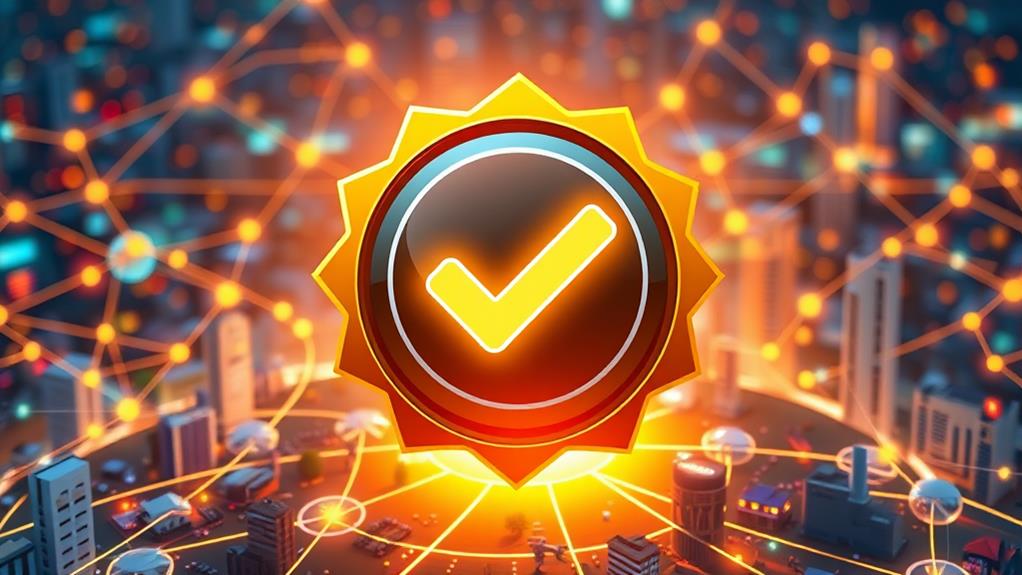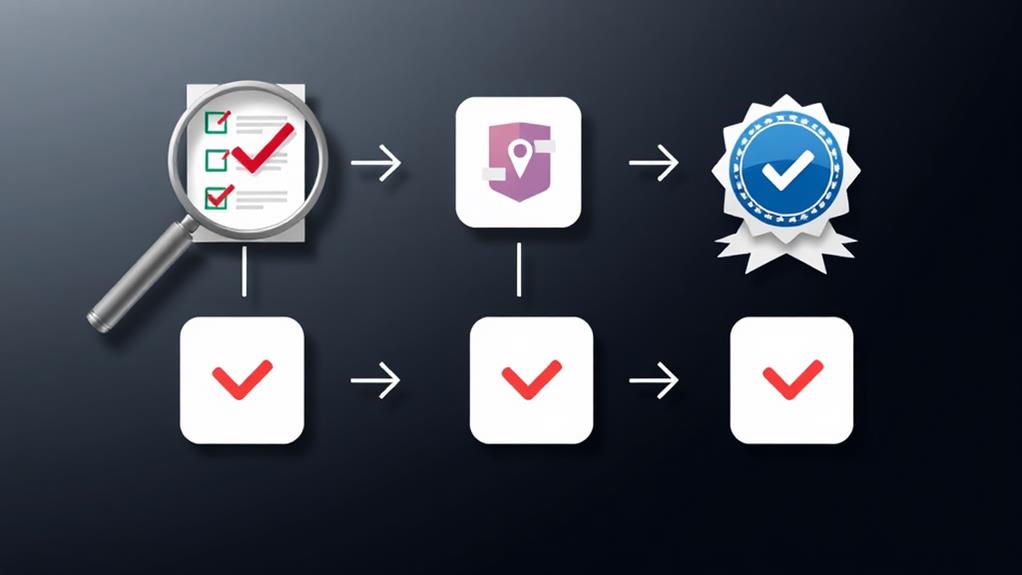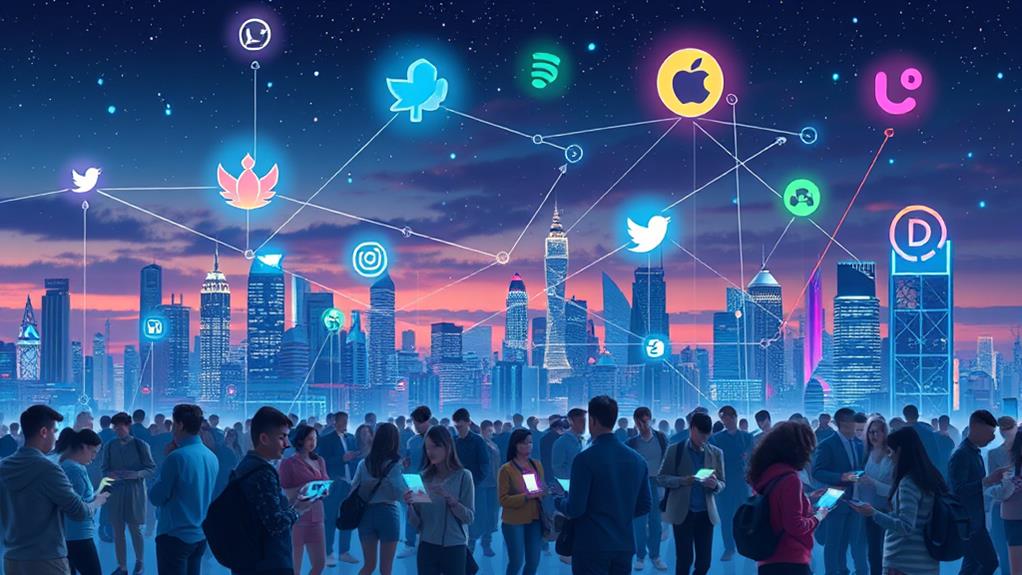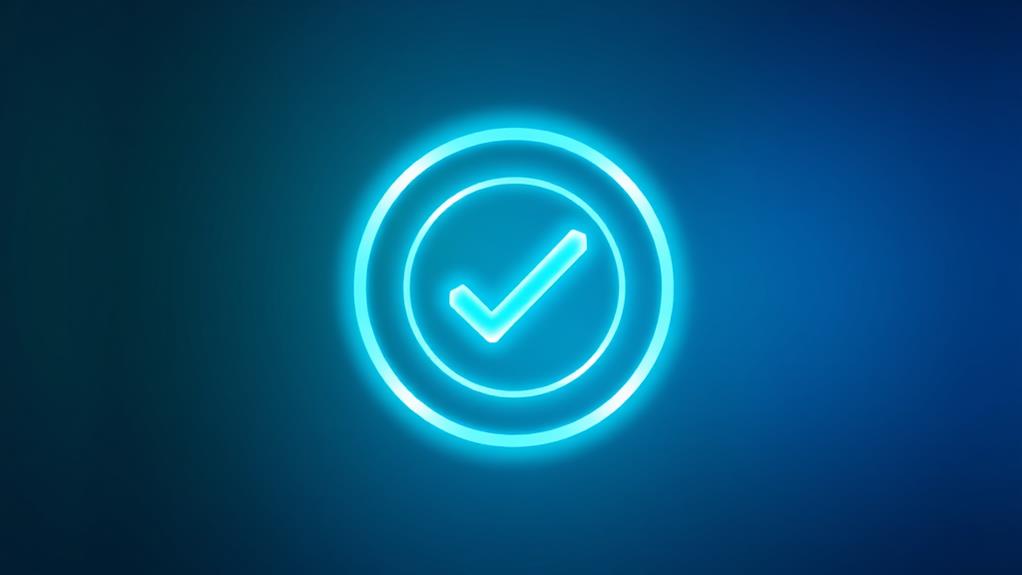A verified logo, like a blue checkmark, signifies that an account is authentic and trustworthy on social media. It helps you identify legitimate entities, reducing the risk of impersonation. Having a verified logo boosts your account's credibility, which can lead to increased visibility in feeds and search results. This credibility builds trust with your audience, enhances engagement, and protects against misinformation. Without it, you might struggle to stand out and face challenges like brand impersonation. Understanding the criteria and steps for verification can further enhance your online presence and influence. Discover how to strengthen your digital reputation effectively.
What Is a Verified Logo?
A verified logo is a symbol, often a blue checkmark, that shows an account on social media has been authentically verified by the platform. This logo signifies that the account is genuine, enhancing its credibility among users. Different social media platforms have their own verification logos; for instance, Facebook offers both blue and gray badges, while Twitter uses the blue checkmark, especially for accounts subscribed to Twitter Blue.
Having a verified logo is important for both individuals and brands, as it helps users quickly identify legitimate accounts, reducing the risk of following impersonators or misleading profiles. With the rise of misinformation, the verified logo serves as a significant asset, establishing trust and authority in a competitive digital landscape.
Additionally, just as strong passwords and security plugins are necessary in protecting online identities, the verified logo plays a key role in safeguarding your brand's reputation in the digital space common entry points for cyber threats.
Moreover, verified accounts often enjoy increased visibility in search results and user feeds, as social media algorithms tend to prioritize these accounts. This means more engagement and potential growth for your brand or personal profile.
Essentially, the verified logo not only boosts your credibility but also enhances your online presence, making it an essential aspect of maneuvering today's social media platforms effectively.
Importance of Verification
Verification plays an essential role in establishing authenticity and trust in the digital world. When you have a verified badge, it not only tells your audience that your account is legitimate but also enhances your overall brand reputation. This is significant in a marketplace where trust is everything, similar to how strong passwords help secure online accounts.
Here are some key reasons why verification matters:
- Authenticity: A verified logo signifies that your account is genuine, helping to build trust with your followers.
- Increased Visibility: Verified accounts often enjoy greater visibility on social media platforms, appearing more prominently in user feeds.
- Protection Against Impersonation: The verified badge serves as a safeguard against impersonators, ensuring your brand image remains intact.
- Credibility and Authority: Being verified helps you stand out in a crowded market, enhancing your reputation and establishing authority in your industry.
Engaging in the verification process is a commitment to growing your brand and boosting your social media presence. This not only leads to higher conversion rates but also fosters stronger connections with your audience.
Benefits of Being Verified

Being verified boosts your brand's credibility and builds trust with your audience.
This verification acts as a form of validation, ensuring that your brand is recognized as authentic and reliable.
With that blue badge, people see you as a reliable source, making them more likely to engage with your content.
This trust can lead to better conversion rates and a stronger presence in your industry, as it enhances your security enhancements and reputation in the digital space.
Enhanced Brand Credibility
How does a verified logo transform your brand's reputation? A verified logo, like the blue checkmark you see on social media platforms, signals authenticity and trustworthiness. This small but powerful symbol can greatly enhance your brand credibility.
Here are four key benefits of having a verified account:
- Increased Legitimacy: Verified accounts are often seen as more legitimate, attracting more followers and engagement.
- Improved Visibility: Brands with a verified logo appear higher in search results, making it harder for impersonators to mislead consumers.
- Better Partnership Opportunities: Your brand or business is more likely to be chosen for influencer marketing and sponsorships, due to the perceived authority that comes with verification.
- Higher Conversion Rates: Consumers tend to trust and engage more with verified brands, leading to improved business performance.
Increased Audience Trust
When you see a verified logo next to a brand's name, it instantly boosts your trust in that account. The blue verification mark signifies authenticity and credibility, which reduces the risk of impersonation. This increased audience trust is essential in today's digital landscape, where misinformation can spread rapidly.
Engaging with a verified social media account feels safer, as you know you're interacting with a legitimate source. Studies show that users are more likely to engage with verified accounts, believing they represent genuine voices. This leads to higher engagement rates and, ultimately, better conversion rates.
When brands are perceived as trustworthy, consumers are more inclined to make purchases or connect with them.
Moreover, verified accounts are prioritized in search results and user feeds, making it easier for you to find and trust these legitimate sources. By fostering stronger community connections, social media verification creates an environment where audiences feel secure.
Verification Requirements
When you're looking to get verified, you need to understand that each platform has its own specific criteria.
Your engagement and growth on these platforms play a significant role in your eligibility.
Additionally, having a well-optimized online presence, such as a reliable top WordPress hosting service, can enhance your credibility.
Plus, knowing the submission process is essential to streamline your verification journey.
Platform-Specific Criteria
Verification requirements vary considerably across social media platforms, each establishing its own unique criteria for users seeking that coveted verified badge.
Here's what you need to know about the platform-specific criteria for verification:
1. Twitter: To get verified, you must maintain an active subscription to Twitter Blue, have a display name and profile photo, confirm your phone number, and guarantee your account's been active in the last 30 days.
2. Instagram and Facebook: Individual profiles must be at least 18 years old, meet activity requirements, and enable two-factor authentication.
For business accounts, authenticity and notability criteria are also essential to secure a Facebook verification badge.
3. LinkedIn: While LinkedIn doesn't offer a verification badge, it emphasizes trust and authenticity through its Premium Membership, which provides a gold logo to subscribers.
4. TikTok: Verified accounts on TikTok display a badge that signifies authenticity, focusing on your ability to deliver reliable content to the platform's user base.
Navigating these platform-specific criteria is vital for achieving verification and enhancing your social media accounts' credibility.
Engagement and Growth
Achieving verification on social media isn't just about meeting basic criteria; it heavily relies on your engagement and growth metrics. Each social media platform has its specific requirements, but they generally prioritize accounts with a significant follower count and higher engagement levels.
For instance, platforms like Instagram require you to have a Business Account and demonstrate consistent content updates and active engagement with your audience.
To improve your chances of verification, focus on maintaining an active posting schedule. Platforms assess your recent activity and will likely favor those who regularly interact with their followers. Higher engagement not only boosts your visibility but also signals your authenticity and significance, critical factors in the verification process.
Additionally, many platforms necessitate two-factor authentication for added security. Submitting identification and showcasing media coverage or remarkable achievements can also enhance your credibility.
Submission Process Essentials
To get that coveted verified logo, you need to understand the specific submission process for each social media platform. Each platform has its own eligibility criteria for verification, so make certain you're prepared.
Here are the essentials you'll need to follow:
- Complete Your Profile: Confirm your business page includes all necessary information, like a profile picture, bio, and contact details.
- Gather Documentation: You'll typically need to submit identification documents, a description of your account's purpose, and relevant URLs that demonstrate your authenticity.
- Enable Security Features: Platforms like Facebook and Instagram require you to enable two-factor authentication, while Twitter mandates a subscription to Twitter Blue.
- Be Patient: After submission, there's usually a review period where the platform evaluates your account's adherence to its verification guidelines and overall activity.
Steps to Achieve Verification

In today's digital landscape, establishing a verified presence is essential for brands aiming to stand out. To achieve verification, you must first clearly define your brand identity and establish a strong position within your industry, which can be enhanced by personalizing your site to reflect your unique branding elements.
This illustrates authenticity, which is vital for gaining trust. Next, focus on engaging storytelling—effectively communicate your brand narrative to attract interest and resonate with your audience.
Highlight notable achievements, media coverage, and any public recognition your brand has received. These elements can greatly boost your credibility during the verification process.
Consistent posting and high audience engagement are also important; active accounts with strong engagement rates are more likely to be considered for verification.
Challenges of Non-Verification
Maneuvering through the challenges of non-verification can be intimidating for brands looking to establish a strong online presence. Without that coveted verification badge, you're likely to face several obstacles that can hinder your growth and credibility.
One of the key issues is the lack of security, as non-verified accounts are more prone to brute force attacks. Here are some key challenges you might encounter:
- Credibility Issues: Consumers often question the authenticity of non-verified accounts, making it harder for you to build trust.
- Impersonation Risks: Without verification, your brand is more susceptible to impersonation, which can severely damage your reputation and mislead customers.
- Lower Visibility: Social media algorithms typically favor verified content, meaning your non-verified posts mightn't reach as wide an audience, reducing engagement.
- Missed Opportunities: Many brands and influencers prefer collaborating with verified accounts. Without verification, you might miss out on valuable partnerships that could elevate your brand.
In the competitive digital landscape, the lack of verification can create barriers to engagement and conversion.
You may need to invest extra time in proving your authenticity, which can slow down your brand's growth and visibility.
Future of Social Media Verification

As we look ahead, the future of social media verification is poised for significant evolution. You'll notice that platforms like Twitter and Meta are already experimenting with subscription models to enhance access to verification features. This shift highlights a growing trend where brands compete for visibility, and social media platforms adapt their verification processes to prioritize authenticity and reward consistent engagement.
Additionally, the importance of securing digital identities parallels the need for strong security measures to protect online presence and sensitive data.
Moreover, emerging technologies such as blockchain could revolutionize verification methods by offering a decentralized approach to account authenticity. This could provide users with a more transparent way to validate the identities of brands and individuals alike. As consumers increasingly seek credible sources of information, the demand for verified accounts is set to grow.
Ongoing reforms in verification policies will likely address issues of misinformation and impersonation, ensuring that verified accounts remain reliable sources within the social media ecosystem.
Conclusion
In a digital world buzzing with information, a verified logo stands as your beacon of trust. It reassures your audience that you're authentic, fostering deeper connections. By pursuing verification, you not only enhance your credibility but also open a domain of opportunities. Don't let the challenges of non-verification dim your shine; embrace the path to authenticity. Remember, in the vast ocean of social media, a verified logo is your lighthouse, guiding followers straight to you.



